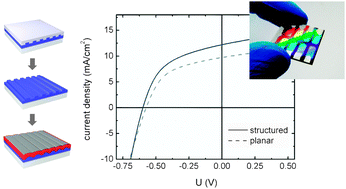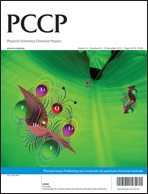Efficiency-improved organic solar cells based on plasticizer assisted soft embossed PEDOT:PSS layers†
Abstract
Organic solar cells (OSCs) have attracted extensive attention as a promising approach for cost-effective photovoltaic devices. This study demonstrates a novel imprinting approach based on additional plasticizing, which is suited for thin polyethylenedioxythiophene:polystyrenesulphonate (PEDOT:PSS) layers. Such films are widely used as electron blocking and hole collecting intermediate layers in OSCs. Master molds with nano-scale channels are used for the temperature and pressure assisted imprinting routine and the shape of the imprinted structures is easily tunable via the plasticizer concentration. Depending on the surface topology of the PEDOT:PSS films structured poly(3-hexylthiophene) (P3HT):phenyl-C61-butyric acid methyl ester (PCBM) bulk heterojunction solar cells have improved power conversion efficiencies in comparison to their planar references. This effect results from enhanced optical absorption due to the resulting textured aluminum


 Please wait while we load your content...
Please wait while we load your content...